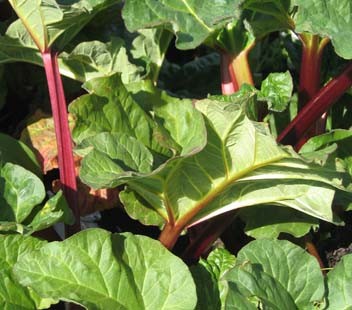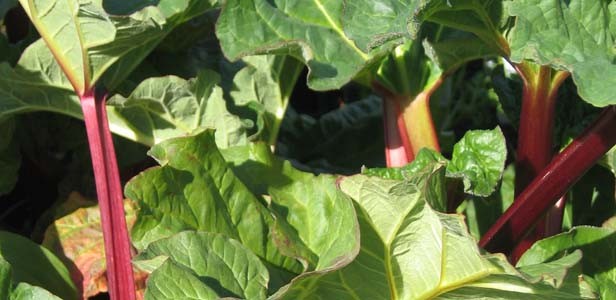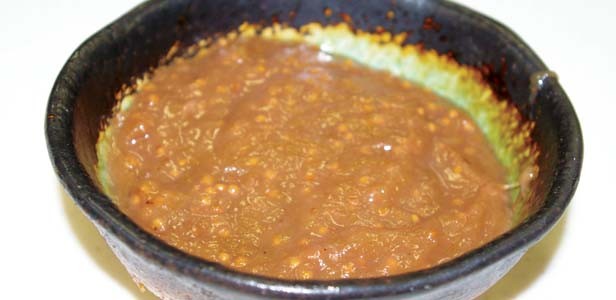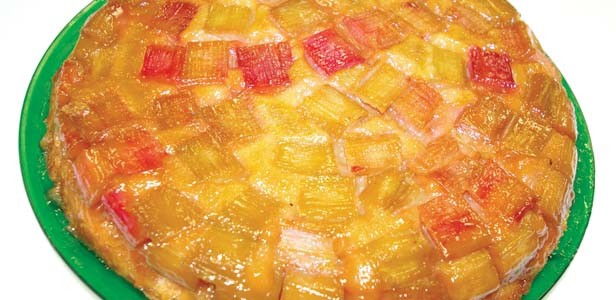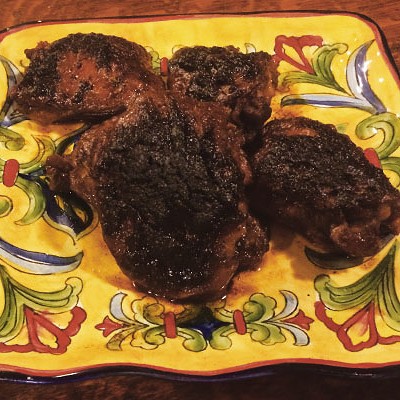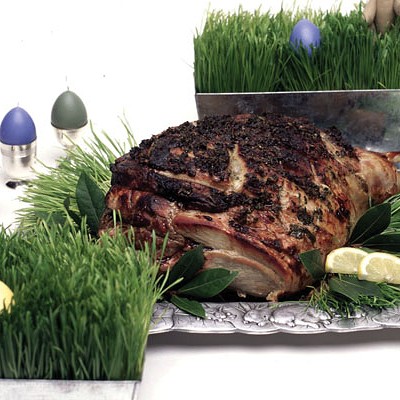Rhubarb: it’s a leafy vegetable that makes such delicious pie that early Americans called it “the pie plant.” It’s a beautiful perennial in the garden: forming a four- or five-foot mound of ruffled leaves with glimpses of ruby red stalks underneath. In spring, huge stalks of flowers shoot forth; both in bud and flower, they look like some weirdly beautiful image a biologist might see under a microscope. I have an arrangement of them on our fireplace mantle.
The stalks are what make that scrumptious pie; the leaves themselves are poisonous. The reason is that they contain high levels of oxalic acid. Small amounts of oxalic acid are found in most leafy dark greens, and dozens of other fruits and vegetables from asparagus to watercress, including sweet corn and strawberries. Fortunately for us, the pale green to ruby red rhubarb stalks are completely and deliciously edible.
Until fairly recently (at least in America) rhubarb was found only in desserts; and mostly in pie form, alone or with strawberries, with which it naturally pairs. These days, it’s showing up all over the menus of chefs and adventurous home cooks. Maldaner’s chef/owner Michael Higgins is currently serving a rhubarb sauce with duck confit. Along with the sugar in his rhubarb preparations, Higgins says that he always likes to use a bit of honey, with which he says rhubarb has a natural affinity. Too much honey can overwhelm rhubarb’s flavor, but just a touch complements it.
Here are two of my favorite non-pie recipes for rhubarb.
Contact Julianne Glatz at [email protected].
RealCuisine Recipe
Rhubarb mostarda
Mostarda – sometimes called Mostarda di frutta – is a classic Italian condiment. It is somewhat like a chutney in that it combines fruit and a savory element. In mostardas that element is mustard. It’s a traditional accompaniment to Bollito Misto (mixed boil), a wintertime dish of an assortment of boiled meats; more recently it’s also being used with cheeses. There are many different versions, some that are regional specialties such as Mostarda di Cremorna (the most famous), Mostarda di Bolognese and Mostarda di Siciliana. Some are made with dried fruits, some with candied fruits, and some with fresh fruit. Pears, quinces, cherries, apricots, figs and peaches are used in Italian mostardas, either singly or in combination. Sometimes the fruit is left whole, or cut into large pieces, other times it is chopped fine.
I created this riff on mostarda after reading one for a cranberry version made by Mario Batali. Italian mostardas contain wine vinegar – red or white, depending on the fruits used – to add a tart note, but both rhubarb and cranberries add enough tartness on their own. Rhubarb mostarda is sweet, tart and spicy; and the mustard seeds provide a textural pop to the smooth sauce. It’s wonderful with pork chops, smoked or au naturel, cheeses, and makes a killer turkey, ham, or cheese sandwich.
- 2 c. sugar
- 2 ½ c. water, divided
- 1 ¼ lb. trimmed rhubarb stalks, cut into ½ pieces
- 3 T. dry mustard, preferably Colman’s
- 2 T. mustard seeds, black, brown or yellow
- ½ - 1 tsp. freshly ground pepper (if using black or brown mustard seeds, use black pepper, for yellow seeds, use white pepper)
- ¼ tsp. Kosher salt, optional
Combine the sugar and two cups of the water in a large heavy-bottomed pan and bring to a boil. Add the rhubarb and cook over high heat, uncovered, for 10 minutes.
While the rhubarb is cooking, whisk the mustard powder and remaining half cup of water in a small bowl until it is smooth, then stir it into the mustard seeds, salt and pepper to the pan.
Cook, uncovered, until the mixture is thick and syrupy. If cooked at a slow boil, this will take about 20 minutes, and must be stirred constantly. Alternatively, reduce the heat to a simmer. This will take longer – about twice as long – but the mixture only needs to be stirred occasionally. Whether it’s cooked at high heat or low, be careful: as the mostarda nears completion, it can easily scorch and burn on the bottom. Remove from the heat and cool completely. It will keep, refrigerated in a tightly sealed container, for several weeks. Makes about 3 cups.
RealCuisine Recipe
Rhubarb upside down cake
Pie may be the quintessential rhubarb dessert, but this upside-down cake also is a delicious showcase for it. Whenever a recipe calls for brown sugar, I almost always use the dark brown, because it has more flavor. (Incidentally, Meijer’s own brand of dark brown sugar is significantly darker – and more flavorful– than any other I’ve ever found.) For this cake, however, I like to use light brown because it shows off rhubarb’s color better.
For the rhubarb topping:
- 4 – 6 stalks fresh rhubarb, or more, depending on the thickness of the stalks
- butter and flour for preparing the skillet
- ½ c. light brown sugar
- ½ c. unsalted butter, softened
For the cake:
- 2¼ c. all-purpose flour
- 2 c. sugar
- 1 tsp. salt
- ½ tsp. baking soda
- 1 c. unsalted butter, softened
- 3 large eggs
- 1 c. plain yoghurt (whole milk preferred, but not necessary)
- 1 tsp. vanilla
It is important that all ingredients for the cake be at room temperature.
Preheat the oven to 350°. Butter and flour the sides of an 10-12-inch iron skillet or other heavy cake pan. You do not need to butter and flour the bottom.
In the bowl of an electric mixer, cream the ½ c. butter and brown sugar until fluffy. (You do not have to clean the bowl before making the cake batter.)
Divide the brown sugar/butter mixture between the ramekins and spread it evenly over the bottoms. Line the bottoms of the ramekins with the rhubarb slices, fitting them together to cover as completely as possible. Set the ramekins aside and reserve any leftover rhubarb for another use.
Make the yoghurt pound cake and fill each ramekin with about ½ c. of the batter, spreading it evenly and leaving a half-inch rim at the top. Use extra batter to make cupcakes or a mini loaf cake.
Bake 55-65 minutes or until a skewer inserted into the middle of the pan comes out clean.
Remove from the oven and immediately run a knife around the insides of the ramekins to loosen the cake. Using hot pads, place the plate you will be using to serve the cake upside down over the top of the skillet and quickly (and carefully) flip it over. Lift the skillet off and replace any rhubarb pieces that might have remained inside or tumbled to the side.
Serve warm or at room temperature. If the cake has cooled, it can be warmed on low in a microwave, if desired. Garnish with a dollop of whipped cream or a small scoop of ice cream. A glass of cold milk is also good!
Note: This can also be made as individual upside down “baby” cakes. Use 8 individual cake pans or ramekins. They should be about 4 inches across and have at least a 1cup capacity. If the stalks are very wide, you may want to cut the pieces in half for these. Proceed as above, filling the ramekins ½ - 2/3 full. Place on a baking sheet, put them in the oven and bake the cakes until a toothpick inserted in the middle comes out clean, 25-35 minutes. Baking time will be longer with ceramic ramekins than individual metal cake pans.

